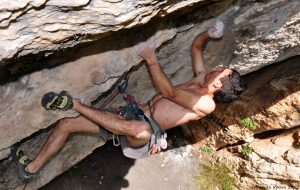Following on you can read a nice article on symmetry in Climbing written by Stefanos Papadopoulos. Stefanos is among the best sport climbers in Greece and he always tries to push his limits on the rocks. As he explains in his article the ‘repetition of a route does not require only muscle strength but also the intellectual capacity of understanding the physical symmetry’. It is a fact that every climbing move we make not only originates in the brain, but also changes the brain.
Written by Stefanos Papadopoulos:

It’s hard to believe how many different movements exist in climbing. I have counted the moves in 10 sport climbing routes with a height of approximately 30 meters each, and recorded more than 350 of them. Notably, the maximum gradient routes had nearly twice as many moves as the more vertical ones. The free repetition of a route does not require only muscle strength but also the intellectual capacity of understanding the physical symmetry. In this instance, the brain and the central nervous system are in a perfect agreement which allows the realization of the required moves. But this is the easy part of the challenge. What about the movements that the body is not used to make and the mind cannot even think of? In this case we should think for a possible solution and push our bodies to implement it, even when the move seems impossible. Such a process may take days, months and even years as we put our bodies in a process of spiritual and physical transformation. More specifically, at first we have to convince the mind that motion is possible. Then we need to facilitate our body’s transformation to the extent that can allow the execution of the moves both with respect to strength, stamina and power endurance. After the new move is achieved, it is stored in the respective memory space in our brain. As a result, this or a similar move is available for repetition, and maybe fine tuning, in the future. Along the way most of the moves are done spontaneously and without much thought. And over time, with the discovery and implementation of several new moves, the body is finally free and unleashed, and becomes symmetric. The real challenge of course begins when we need to connect various moves together. Given this, and so many other factors that need to be considered such as the endurance, the muscle memory, the climber’s height, the need for spontaneous decisions etc., it all becomes much more difficult.
“A symmetric body in climbing is the body that is capable of being adjusted to implement any move.”



Leave a Reply